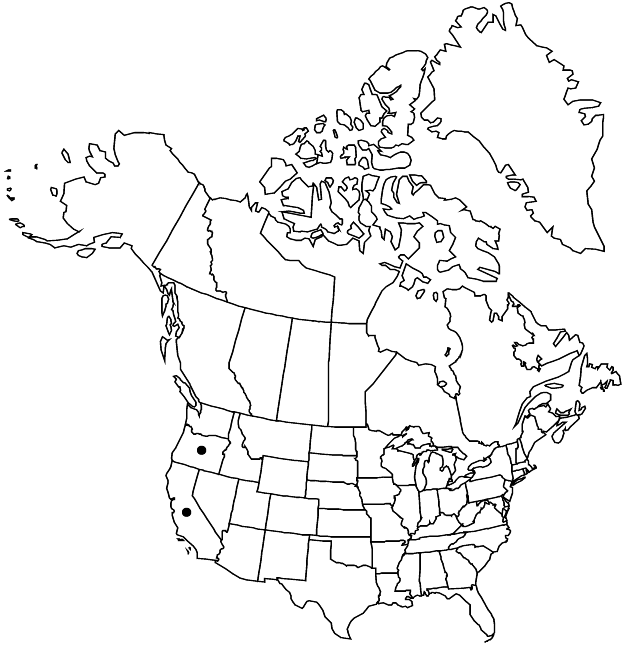Difference between revisions of "Eriogonum diclinum"
Aliso 7: 218. 1970.
FNA>Volume Importer |
FNA>Volume Importer |
||
| Line 24: | Line 24: | ||
|elevation=1800-2400 m | |elevation=1800-2400 m | ||
|distribution=Calif.;Oreg. | |distribution=Calif.;Oreg. | ||
| − | |discussion=<p>Eriogonum diclinum is found infrequently in the Siskiyou and Trinity mountains of northwest California (Siskiyou and Trinity counties) and southwest Oregon (Jackson and Josephine counties). The species approaches E. incanum in aspect, and reports of that species in Oregon were based on staminate specimens of E. diclinum.</p> | + | |discussion=<p><i>Eriogonum diclinum</i> is found infrequently in the Siskiyou and Trinity mountains of northwest California (Siskiyou and Trinity counties) and southwest Oregon (Jackson and Josephine counties). The species approaches <i>E. incanum</i> in aspect, and reports of that species in Oregon were based on staminate specimens of <i>E. diclinum</i>.</p> |
|tables= | |tables= | ||
|references= | |references= | ||
| Line 48: | Line 48: | ||
|publication year=1970 | |publication year=1970 | ||
|special status= | |special status= | ||
| − | |source xml=https://jpend@bitbucket.org/aafc-mbb/fna-data-curation.git/src/ | + | |source xml=https://jpend@bitbucket.org/aafc-mbb/fna-data-curation.git/src/8f726806613d60c220dc4493de13607dd3150896/coarse_grained_fna_xml/V5/V5_752.xml |
|subfamily=Polygonaceae subfam. Eriogonoideae | |subfamily=Polygonaceae subfam. Eriogonoideae | ||
|genus=Eriogonum | |genus=Eriogonum | ||
Revision as of 17:41, 18 September 2019
Herbs, matted, dioecious, (0.5–)1–2 × 3–8 dm, sparsely tomentose. Stems: caudex spreading; aerial flowering stems erect, slender, solid, not fistulose, arising at nodes of caudex branches and at distal nodes of short, nonflowering aerial branches, (0.5–)1–2 dm, sparsely tomentose. Leaves in loose basal rosettes; petiole 0.7–3 cm, lanate to tomentose; blade elliptic to ovate, (0.5–)1–2 × 0.5–1.5 cm, densely grayish-lanate on both surfaces, margins entire, plane. Inflorescences: staminate plants capitate, rarely umbellate, 1–2 × 1–2 cm; pistillate plants capitate, rarely umbellate, 1–4 × 1–4 cm; branches tomentose to floccose; bracts 4–6, semileaflike to leaflike, 3–5 × 1–3 mm. Involucres 1 per node or 2–3 per cluster, turbinate to turbinate-campanulate, tomentose; staminate plants 2.5–3 × 3–4 mm, teeth 5–6, erect, 1.5–2 mm; pistillate plants 3–4 × 3–4 mm, teeth 4–5, erect, 2.5–3.5 mm. Flowers: perianth yellow to brownish yellow, glabrous; staminate flowers 2–3 mm, including 0.5–0.7 mm stipelike base; pistillate flowers (3.5–)5–8 mm, including 0.5–0.8 mm stipelike base; tepals monomorphic, oblanceolate to obovate; stamens exserted, 1–2 mm; filaments pilose proximally. Achenes light brown to brown, 3–4 mm, glabrous except for sparsely pubescent beak.
Phenology: Flowering Jun–Sep.
Habitat: Gravelly serpentine flats and slopes, sagebrush communities, montane conifer woodlands
Elevation: 1800-2400 m
Discussion
Eriogonum diclinum is found infrequently in the Siskiyou and Trinity mountains of northwest California (Siskiyou and Trinity counties) and southwest Oregon (Jackson and Josephine counties). The species approaches E. incanum in aspect, and reports of that species in Oregon were based on staminate specimens of E. diclinum.
Selected References
None.
